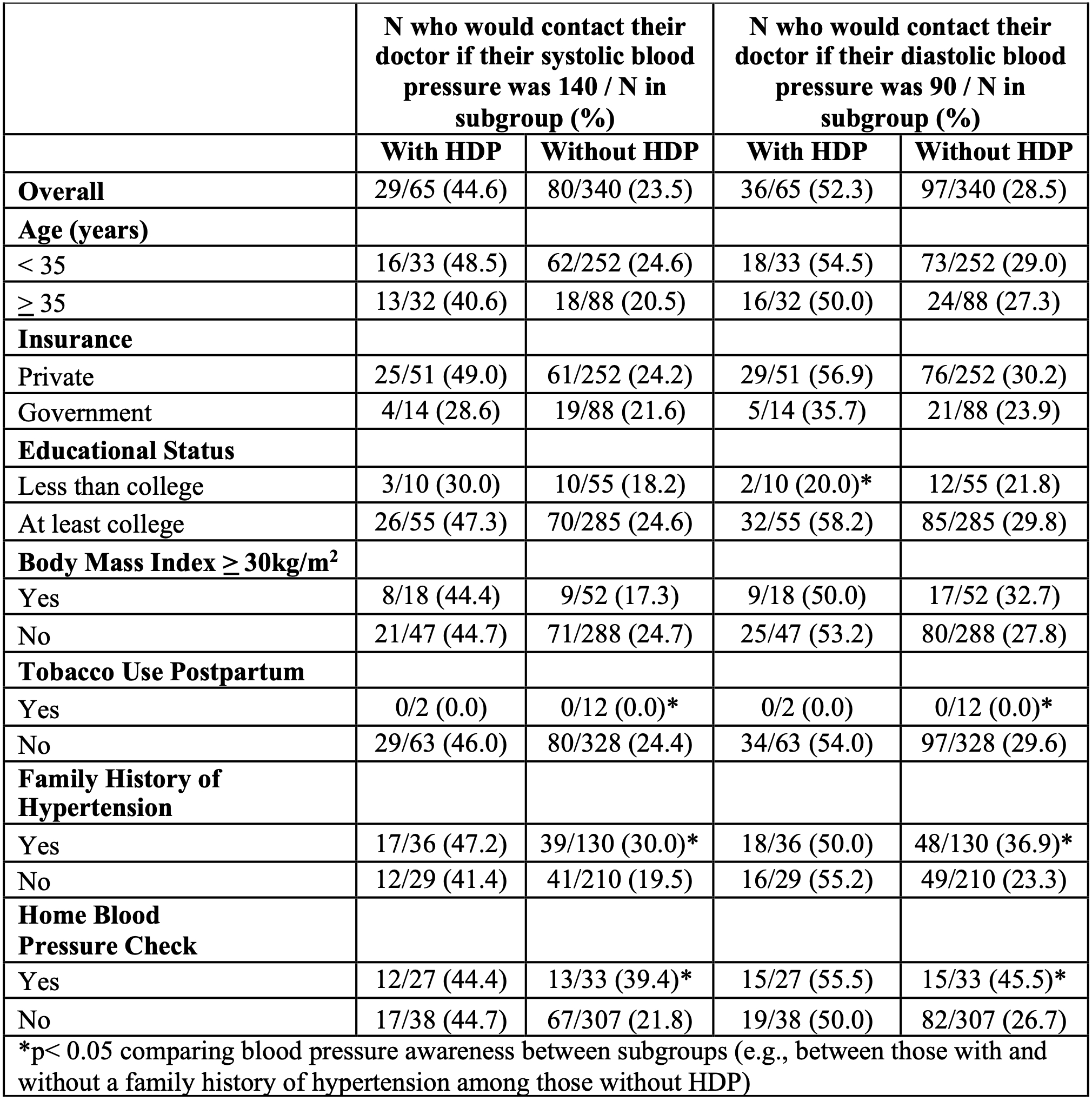Final ID: P-190
Blood pressure monitoring and knowledge in the first year after a hypertensive disorder of pregnancy
Abstract Body: Introduction. In the first year postpartum, hypertension (HTN) is a leading cause of morbidity and mortality, particularly for those with hypertensive disorders of pregnancy (HDP). Timely recognition of HTN is key to reducing short- and long-term cardiovascular risk among birthing people. Therefore, we assessed knowledge of when to seek medical attention for blood pressure (BP) elevations and rates of BP measurement in the first year postpartum among those with and without HDP.
Methods. This was a secondary analysis of primiparas who participated in a randomized trial of prenatal counseling to improve postpartum health. We included 405 participants who self-reported information on postpartum BP assessment. We calculated (1) the proportion of participants who stated they would contact a clinician for a systolic BP above 140 and a diastolic BP above 90 at 3-months postpartum and (2) the frequency and location of BP checks reported from 3-12 months postpartum among those with and without HDP. Subgroup analyses compared BP knowledge by sociodemographic and health-related factors.
Results. Participants were 32 +/-5 years, 16% reported a HDP, 60% identified as White, 75% had private insurance, and 84% had > college education. For systolic BP, 44.6% with HDP and 23.5% without HDP identified a BP of 140 as the threshold above which they would contact a clinician (p<0.01); for diastolic BP, 52.4% with HDP and 28.5% without identified a BP threshold of 90 (p<0.01).From 3-12 months postpartum, 83.1% with HDP and 59.4% without HDP had a BP check (p < 0.01); 41.6% with HDP and 9.7 % without HDP checked their BP at home (p<0.01). Home monitoring was not associated with awareness of when to contact a physician for hypertension among those with HDP (TABLE). BP awareness was higher among people who had private health insurance, > college education and were non-smokers.
Conclusions. Efforts are needed to improve postpartum BP assessment, self-monitoring, and awareness of when to seek medical attention for HTN, among birthing people with and without HDP.
Methods. This was a secondary analysis of primiparas who participated in a randomized trial of prenatal counseling to improve postpartum health. We included 405 participants who self-reported information on postpartum BP assessment. We calculated (1) the proportion of participants who stated they would contact a clinician for a systolic BP above 140 and a diastolic BP above 90 at 3-months postpartum and (2) the frequency and location of BP checks reported from 3-12 months postpartum among those with and without HDP. Subgroup analyses compared BP knowledge by sociodemographic and health-related factors.
Results. Participants were 32 +/-5 years, 16% reported a HDP, 60% identified as White, 75% had private insurance, and 84% had > college education. For systolic BP, 44.6% with HDP and 23.5% without HDP identified a BP of 140 as the threshold above which they would contact a clinician (p<0.01); for diastolic BP, 52.4% with HDP and 28.5% without identified a BP threshold of 90 (p<0.01).From 3-12 months postpartum, 83.1% with HDP and 59.4% without HDP had a BP check (p < 0.01); 41.6% with HDP and 9.7 % without HDP checked their BP at home (p<0.01). Home monitoring was not associated with awareness of when to contact a physician for hypertension among those with HDP (TABLE). BP awareness was higher among people who had private health insurance, > college education and were non-smokers.
Conclusions. Efforts are needed to improve postpartum BP assessment, self-monitoring, and awareness of when to seek medical attention for HTN, among birthing people with and without HDP.
More abstracts on this topic:
AI-Enabled Photoplethysmography Can Help Detect Elevated Blood Pressure And Predict Near-Term Incidence Of Hypertension
Di Achille Paolo, Su Hao-wei, Ko Ho, Taylor James, Shreibati Jacqueline, Thompson Matthew, Poh Ming-zher
A Key Role of Proximal Tubule Renin-Angiotensin System in The Kidney in The Development of Kidney Ischemia and Reperfusion InjuryLi Xiao, Hassan Rumana, Katsurada Akemi, Sato Ryosuke, Zhuo Jia

